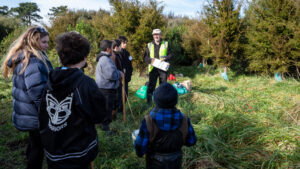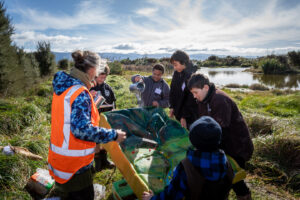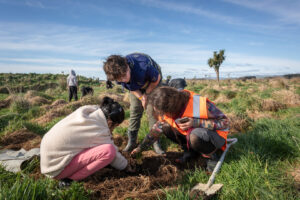
Working together for Wairarapa wetlands.
Climate action education is talked about as holistic pedagogy that has positive impacts for wellbeing and sense of belonging/place through connection and relationship with te taiao. A day of engagement held in the Wairarapa encapsulates this. Enviroschools Facilitator, Gill Stewart, tells us what happened.
The hope and vision we all share is for people, young and old, to be reconnecting with the natural environment – te taiao, and within our region, reconnecting with Wairarapa Moana and her wider whaitua (catchment). For this day we were hoping to highlight what wetlands do to keep us safe and sustain us in these times of unsettling climate change.
- What are wetlands?
- How big was Wairarapa Moana and wetlands in the past?
- Why are there so many swans here and grass in the water?
- Are the wetlands swollen?
These were a few of the initial wonderings of the young people who participated in the Enviroschools Wetland Wondering Day on Friday 4th August 2023. The event was a collaboration between the Wairarapa Moana Project’s Team from Greater Wellington Regional Council, Kohunui Marae members and Enviroschools.
The incentive for providing this wetland experience came from a combination of contexts. Mana whenua expressed a desire to tell their stories and share their wisdom with our young people. Schools are developing curriculum that is based on engaging with mana whenua in our local places. Enviroschools are actively engaging in climate education. These, woven together, create a great opportunity to work together to understand wetlands and take action for them.

Victoria University researcher explains the methods of measuring growth.

Measuring totara trees to establish growth rates.

Enviroschools Facilitator, Amanda, helps participants experiment with the catchment model to understand flow of water and nutrients.
Ākonga from four schools participated in a wide range of activities during the event including:
- measuring trees with a Victoria University researcher, experiencing how we need to work out the best methods to restore our wetlands,
- participating in demonstrating how catchments work and the important role wetlands play,
- weaving harakeke caterpillars with Whaea Violet, and hearing from her about how Wairarapa Moana was once the food basket for her whānau,
- an activity that encouraged slowing down, observing and imagining from the perspective of the wetland ecosystem then expressing this creative writing.

Whaea Violet has everyone engaged with her stories and weaving knowledge.

Harakeke caterpillars
Throughout the day we had been intrigued and inspired by the team of contractors busy planting some of the 22,000 plants going into the Kahutara Lagoon, so after being re-energised by a hot chocolate and sausage, we were all ready to take action and contribute to the restoration of the wetlands by helping with some of this planting. Each plant was lovingly held, eased into the soil and then tucked into its new home with a wool mat by the young people.

Hot cocoa comfort on the couch.

Enviroschools Facilitator, Michelle, helps with planting techniques.
The young participants went away, excited to share with their peers how wetlands can help with flooding, what a catchment is, and how to plant trees. These ākonga know that wherever they are in their local catchment they can make a difference. They are eager to find out more about the possibilities of planting in and around the school and community.
The wonderings at the end of day were:
- How will the catchments cope in the future?
- How long will it take to restore the wetlands?
- How long will those trees take to grow to become a forest?
“When can we come again?” – a participant was overheard saying.
Thank you to the support of Kohunui Marae, Dept of Conservation, the Mauri Oho Project, Mountains to Sea Wellington, South Wairarapa District Council, Carterton District Council and Zip Plumbing, Masterton and Little Green Dunny.
Photos by Andrew Stewart